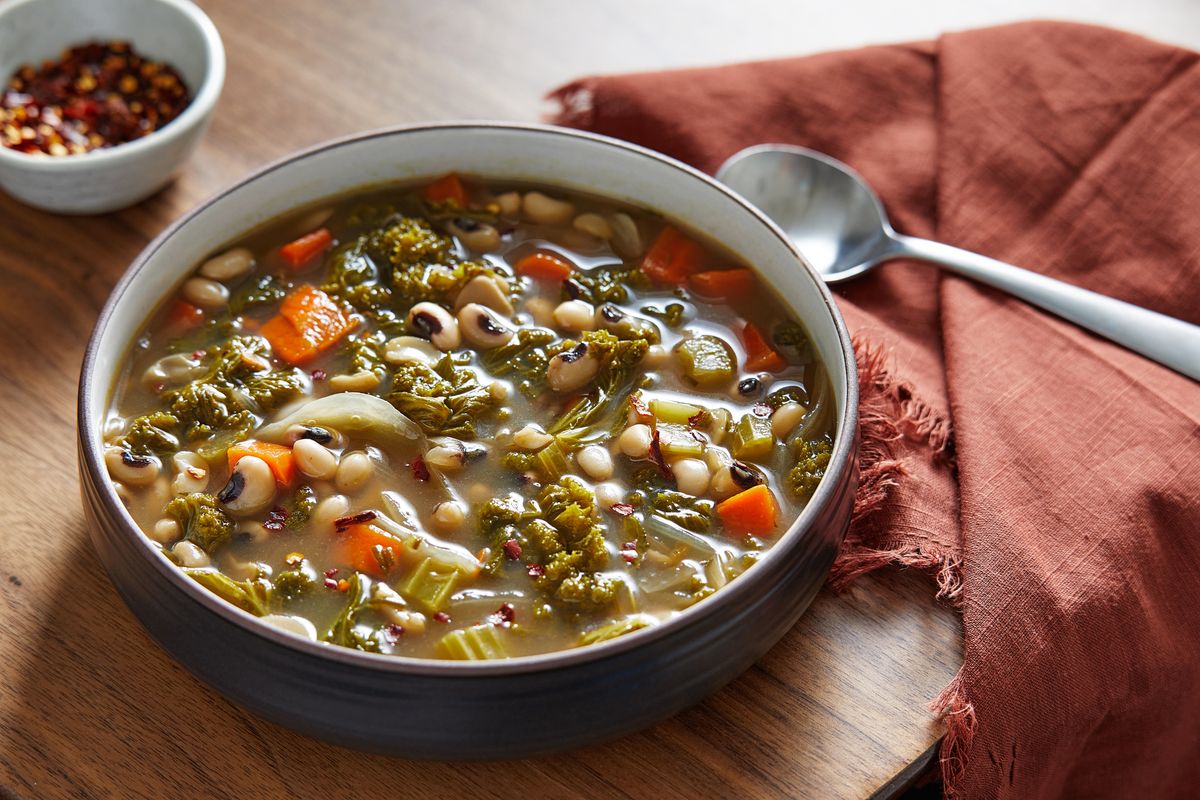Black-eyed peas and mustard greens give Italian soup a Southern flair

My household has a love-hate relationship with black-eyed peas. In short: I love them, and my husband hates them.
We’re both from Texas, with roots in Georgia (mine) and Louisiana (his), so when we were first dating a dozen years ago and he told me of his distaste, and proceeded to add lima beans and okra to the list, I couldn’t help but ask, “Are you sure you’re Southern?” Much to his chagrin, I’ve made a joke along those lines every chance I’ve gotten since.
Food and identity are intertwined, perhaps inextricably so. As French epicure Jean Anthelme Brillat-Savarin famously put it, “Tell me what you eat: I will tell you what you are.” But that doesn’t make those definitions simple or straightforward.
I am the grandson of Assyrian refugees, and my earliest food memories come from my Midwestern mother, whose ancestry was mostly German, although I also remember the cooking of my father’s sisters from regular summer visits to Chicago. I’ve spent almost equal numbers of years living in each of these three places: Texas, New England and, most recently, Washington, D.C. All of that has informed my eating and cooking – and has made me who I am in countless other ways, too – but ultimately, I feel like a Southerner. The foods of the Middle East feed my spirit, as if the ancestors I never met are tasting them right alongside me, but so do the foods of the American South.
A new cookbook from Vishwesh Bhatt speaks to similar feelings of layered identity. In “I Am From Here,” the chef writes lyrically about his upbringing in the southern Indian state of Gujarat – and his immersion for decades in the American South. Executive chef of the Snackbar in Oxford, Miss., (where I have tasted his food when I’ve attended Southern Foodways Alliance symposia), Bhatt showcases the parallel beloved ingredients of both cuisines: greens, rice, tomatoes, okra, pickles and, of course, black-eyed peas and other legumes. “I want people to see me as I see myself: an immigrant, a son of immigrants, who chose to make the South his home, and in doing so became a Southern chef,” he writes.
Bhatt was raised vegetarian, and while his cookbook is not, the plant-forward nature of his cooking is obvious. And so are those connections between India and the South. His grilled cheese sandwiches include slow-roasted tomatoes and chaat masala, but also smears of Southern favorite Duke’s mayonnaise. He uses coconut milk, cardamom, ginger and more to turn creamed corn into corn korma. He features a stunning peanut curry, which is no mash-up but a dish from his grandmother that reminds me of a Sri Lankan cashew curry I fell in love with a few months ago.
For his Black-Eyed Pea and Mustard Green Soup, Bhatt writes that he created this gorgeous soup to feed a delegation of Italian guests. “I wanted something that would be familiar to them, yet rooted in Mississippi,” he writes. “I came up with this warming, filling soup, which plays on Italian minestra but employs a quintessentially Southern combination of peas and greens.” It’s a wonderfully seasonal main-course soup that packs some serious heat from the mustard greens – one of my absolutely favorite leafy vegetables – and a heavy dose of crushed red pepper flakes, but you can use other greens and tone down the pepper, if you’d like.
Bhatt likes to use dried lady peas or crowder peas because they cook quickly from dried, but black-eyed peas work beautifully and are much easier to find outside the heart of the South. I made my big batch with the latter, and froze it for my own future lunches, but when those run out I’ll switch to another field pea the next time I make it. The soup will be just as tasty, and just as Southern, but perhaps a touch more supportive of marital harmony. Serve with crusty bread.
Black-Eyed Pea and Mustard Green Soup
1 hour, plus overnight soaking time
8 ounces dried field peas, such as lady peas, crowder peas or black-eyed peas, soaked overnight, rinsed and drained
1 tablespoon olive oil
1 small yellow or white onion (6 ounces), thinly sliced
2 medium carrots (10 ounces total), scrubbed and diced
2 celery stalks, diced
5 cloves garlic, thinly sliced
6 cups no-salt-added vegetable broth
1 small bunch mustard greens (4 ounces), stemmed and chopped
1 tablespoon balsamic vinegar, plus more to taste
1 tablespoon chopped fresh rosemary
1 teaspoon fine sea salt, plus more to taste
1/2 teaspoon crushed red pepper flakes, plus more to taste
In a large saucepan over medium-high heat, heat the oil until it shimmers. Add the onion and cook, stirring frequently, until softened, 6 minutes. Add the carrots, celery and garlic and cook, stirring occasionally, until the onion starts to turn golden, 8 to 9 minutes.
Add the soaked peas and vegetable broth and bring to a boil. Reduce the heat so the liquid is at a simmer, cover and cook until the peas are just beginning to soften, 12 to 15 minutes. Stir in the greens, vinegar, rosemary, salt and red pepper flakes, re-cover, and cook until the peas and greens are tender, 10 to 12 minutes.
Taste, and season with more vinegar, salt and/or red pepper flakes as needed. Divide among serving bowls and serve hot.
4 to 6 servings
Storage Notes: Refrigerate for up to 1 week or freeze for up to 6 months.
Nutrition information per serving (1 1/2 cups), based on 6 | Calories: 199; Total Fat: 4 g; Saturated Fat: 0 g; Cholesterol: 0 mg; Sodium: 614 mg; Carbohydrates: 39 g; Dietary Fiber: 9 g; Sugar: 9 g; Protein: 10 g
This analysis is an estimate based on available ingredients and this preparation. It should not substitute for a dietitian’s or nutritionist’s advice.
Adapted from “I Am From Here” by Vishwesh Bhatt” (W.W. Norton, 2022).